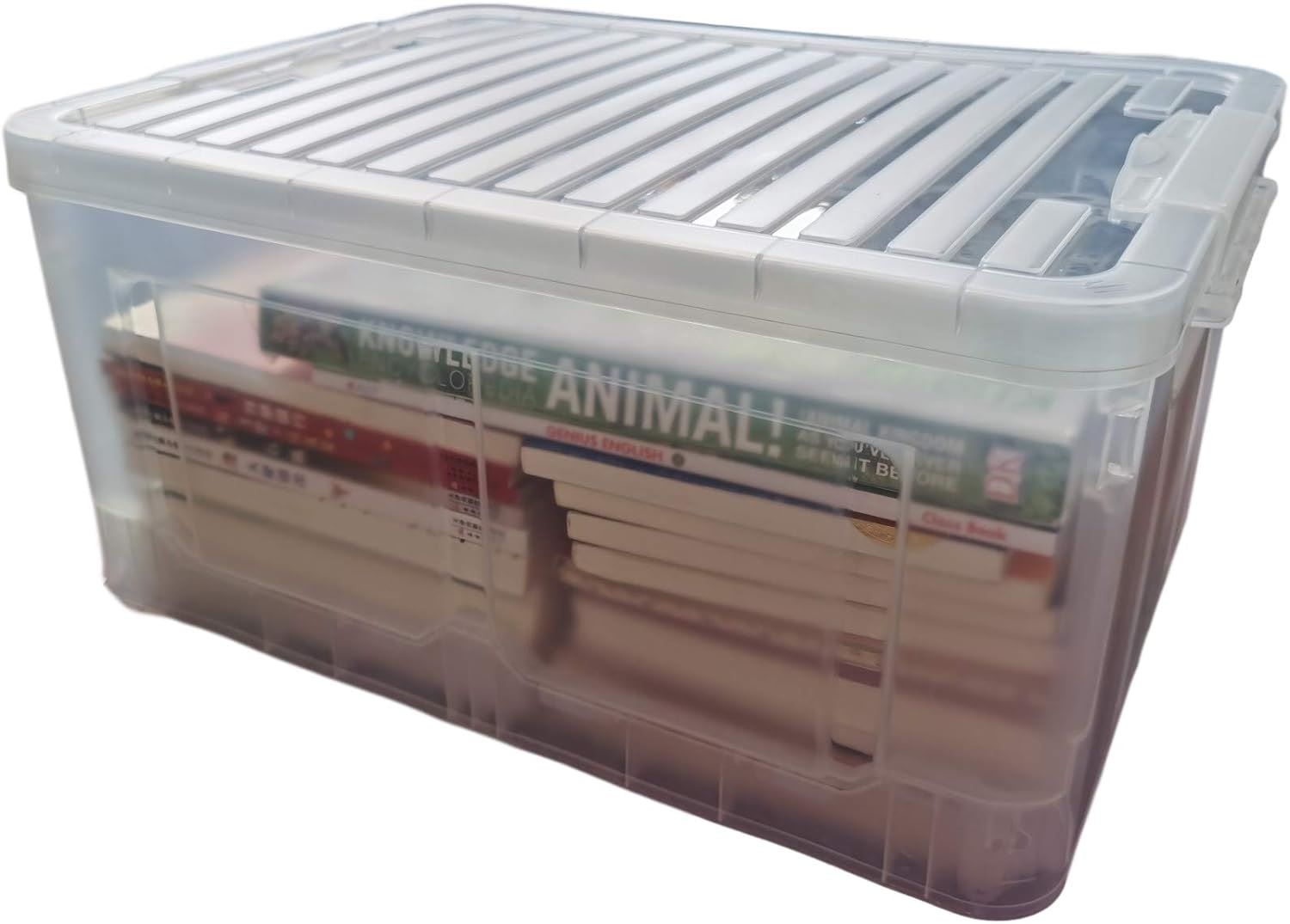

Articles
How To Store Books In Attic
Modified: January 18, 2024
Learn the best ways to store articles and books in your attic to protect them from damage. Proper storage techniques can help preserve their condition for years to come.
(Many of the links in this article redirect to a specific reviewed product. Your purchase of these products through affiliate links helps to generate commission for Storables.com, at no extra cost. Learn more)
Introduction
Storing books in the attic can be a great solution for those who have limited space in their homes. Attics provide a convenient and accessible storage area, allowing you to keep your beloved books safe and protected. However, storing books in the attic requires careful planning and consideration to ensure their preservation.
In this article, we will guide you through the process of storing books in the attic, from assessing the space to organizing and maintaining your book collection. We will provide you with valuable tips and insights on how to protect your books from potential damage caused by temperature fluctuations, humidity, dust, and pests.
So, if you are ready to reclaim your living space while still keeping your precious books close by, let’s dive into the world of attic book storage.
Key Takeaways:
- Properly storing books in the attic requires careful assessment of space, preparation for temperature and humidity control, and the use of suitable storage containers to protect against dust and pests.
- Regular maintenance, organization, and monitoring of stored books in the attic are essential for long-term preservation, ensuring that your cherished collection remains in good condition for years to come.
Read more: How To Store Kids Books
Assessing the Attic Space
The first step in storing books in the attic is to assess the available space and determine if it is suitable for storing your collection. Attics can come in various shapes and sizes, so it is important to evaluate the attic space carefully.
Start by measuring the dimensions of the attic, taking note of any sloping ceilings or beams that may limit the usable storage area. Consider the weight-bearing capacity of the attic floor to ensure it can support the weight of your books. If you are unsure about the structural integrity, it is wise to consult with a professional before proceeding.
Next, assess the conditions within the attic. Check for signs of water leakage or moisture, as excessive humidity can damage books. Look for any signs of pests such as rodents or insects, as they can cause significant harm to your collection.
Lastly, consider the accessibility of the attic space. Will you need to climb stairs or use a ladder to reach it? Make sure that you have a safe and convenient way to access and retrieve your books, especially if you plan on frequently adding or removing items from storage.
By carefully assessing the attic space, you can determine if it is suitable for storing your books and identify any necessary modifications or precautions that need to be taken before proceeding.
Preparing the Attic for Book Storage
Before you start storing your books in the attic, it is crucial to prepare the space properly to ensure the books remain in good condition. Here are some important steps to follow:
Clean and declutter: Remove any dust, debris, or unnecessary items from the attic. A clean and clutter-free space will help prevent dirt and dust from settling on your books and protect them from potential damage.
Insulate and seal: Proper insulation and sealing play a crucial role in maintaining a stable environment for your books. Ensure that the attic is well-insulated to prevent extreme temperature fluctuations. Seal any gaps or cracks that could allow unwanted air or moisture to enter the space.
Install ventilation: Adequate ventilation is important to prevent the buildup of moisture, which can lead to mold and mildew growth. Consider installing proper ventilation, such as vents or fans, to ensure a consistent airflow within the attic.
Protect against pests: Take preventative measures to keep pests away from your books. Seal any entry points that pests could use to enter the attic, such as holes or gaps. Consider using pest-control measures like traps or repellents to safeguard your collection.
Consider fire safety: Ensure that the attic is equipped with smoke detectors and fire extinguishers. Store books away from electrical wires or any potential fire hazards.
Label and inventory: Before storing your books, create a detailed inventory and labeling system. This will help you easily locate specific books when needed and ensure that they are stored in a way that prevents damage.
By following these steps, you can create a favorable environment in your attic for storing books and minimize the risk of damage or deterioration to your collection.
Controlling Temperature and Humidity
Temperature and humidity are critical factors to consider when storing books in the attic. Fluctuations in temperature and excess moisture can cause irreversible damage to your collection. Here are some tips for controlling temperature and humidity in your attic:
Temperature:
- Ensure that the attic remains within a moderate temperature range, ideally between 60-75 degrees Fahrenheit (15-24 degrees Celsius).
- Avoid extreme temperature fluctuations, as rapid changes can result in book damage.
- If your attic is prone to extreme temperatures, consider insulating the space or using a temperature-regulating system, such as a dehumidifier or air conditioner.
Humidity:
- Maintain a relative humidity level between 30-50%. Excessive moisture can lead to mold, mildew, and the deterioration of paper materials.
- Monitor humidity levels using a hygrometer. Place it in a central area of the attic to get an accurate reading of the overall humidity.
- Control humidity by utilizing dehumidifiers, fans, or air conditioning. These devices help to remove excess moisture from the air, creating a more stable environment.
- Avoid storing books directly on the floor, as it can be a source of moisture. Use pallets, shelves, or plastic bins to elevate books off the ground.
By monitoring and controlling temperature and humidity levels in your attic, you can create a suitable environment for book storage and protect your collection from the damaging effects of moisture and extreme temperatures.
Choosing the Right Storage Containers
When storing books in the attic, selecting the right storage containers is essential to ensure their protection and longevity. Here are some considerations for choosing the right containers:
Material:
- Opt for containers made of acid-free and archival-quality materials. Acid-free containers prevent the transfer of acids to the books, which can cause deterioration over time.
- Choose containers that are sturdy and durable, able to withstand the weight of books and protect them from potential damage.
- Avoid containers made of plastic or materials that emit volatile organic compounds (VOCs) as they can potentially harm books.
Size and Shape:
- Select containers that can comfortably accommodate your books without cramming them too tightly. Leave some room to allow for air circulation and prevent damage caused by overcrowding.
- Consider rectangular or square-shaped containers as they maximize space utilization and make stacking and organizing books more efficient.
Lids and Closures:
- Choose containers with secure lids or closures to protect against dust, pests, and moisture.
- Ensure that the lids fit tightly to prevent any entry of unwanted elements.
Transparency:
- If possible, select containers that are transparent or have clear panels. This allows you to easily see the contents of each container without having to open them, making it more convenient to locate specific books.
Stackability:
- Opt for containers that are stackable, as this helps maximize the use of vertical space in the attic.
- Ensure that the containers are sturdy enough to withstand being stacked without collapsing or causing damage to the books inside.
By carefully selecting the right storage containers, you can provide a safe and organized environment for your books in the attic while minimizing the risk of damage or deterioration.
When storing books in the attic, make sure to use plastic bins or boxes with lids to protect them from dust and moisture. Keep the boxes off the ground and away from any potential leaks or pests.
Read more: How To Store A Lot Of Books
Sorting and Organizing Your Book Collection
Properly sorting and organizing your book collection is crucial for easy retrieval and maintenance. Here are some tips to effectively sort and organize your books in the attic:
Sort by Category or Genre:
- Categorize your books based on genre, author, or subject matter. This will make it easier to locate specific books when needed.
- Create clear labels or tags for each category to ensure that books are returned to their proper place after use.
Consider Size and Weight:
- When storing books, consider their size and weight. Place heavier books at the bottom of the containers or on lower shelves to prevent them from damaging lighter books.
- Separate larger books from smaller ones or use dividers to prevent them from leaning or causing damage to adjacent books.
Utilize Bookends and Dividers:
- Use bookends or dividers to keep books upright and prevent them from falling over or getting damaged during storage.
- Bookends can also be used to separate categories or sections within a container or on a shelf.
Create an Inventory:
- Maintain a detailed inventory of your book collection, noting the title, author, and location of each book. This will help you keep track of your collection and find books easily.
- Consider digital options such as creating a spreadsheet or using inventory management apps to keep your records organized.
Arrange Books for Easy Access:
- Place frequently accessed books near the front of the storage area for easy retrieval.
- Organize books in a way that allows you to easily see the spines and titles to quickly locate specific books.
Protect Special or Valuable Books:
- If you have special or valuable books in your collection, consider wrapping them in acid-free paper or placing them in archival-quality sleeves for added protection.
- Store delicate or rare books separately and handle them with extra care to prevent any accidental damage.
By following these tips, you can ensure that your book collection is properly sorted and organized in the attic, making it easier to find and maintain your books for years to come.
Stacking and Arranging Books in the Attic
When it comes to stacking and arranging books in the attic, it’s important to prioritize safety and accessibility while maximizing space utilization. Here are some tips to consider:
Stacking Books:
- Ensure that books are stacked vertically or upright to minimize stress on the spines and prevent warping.
- Avoid overly tight or cramped stacks that can damage the books. Leave some breathing space between the stacks to allow for air circulation.
- Consider using bookends or dividers to prevent books from leaning and to maintain an organized stack.
Shelving and Storage Units:
- If you have built-in shelving or storage units in your attic, use them to your advantage. Place books on the shelves in an organized manner, following your chosen sorting system.
- If no shelving is available, consider installing freestanding shelves or cabinets to create a neat and orderly storage space.
- Ensure that shelves are sturdy and can support the weight of the books. Reinforce them if necessary.
Utilize Plastic Bins:
- If using plastic bins to store books, stack them in a stable and secure manner, with heavier bins on the bottom and lighter bins on top.
- Label the bins clearly, indicating the contents or categories of books stored inside.
- Consider using clear plastic bins to allow for easy identification of books without needing to open the bins.
Accessible Areas:
- Keep frequently accessed books within reach or in easily accessible areas of the attic. This will save time and effort when retrieving them.
- If stacking books up to the ceiling, place less frequently used books on higher shelves or in bins at the top to make room for the more frequently accessed ones at eye level.
Consider Weight:
- Take into account the weight-bearing capacity of the attic floor and shelves. Avoid overloading them with heavy stacks of books to prevent any structural damage or accidents.
- Spread the weight evenly across the storage area to maintain a balanced distribution.
By following these tips, you can effectively stack and arrange your books in the attic, ensuring both the safety of the books and ease of access whenever you need them. Remember to monitor the storage area periodically to make any necessary adjustments or reorganization as your book collection grows.
Protecting Books from Dust and Pests
Keeping your books free from dust and protected from pests is crucial for maintaining their condition and longevity. Here are some effective strategies for protecting your books in the attic:
Dust Prevention:
- Regularly dust the attic space to minimize the buildup of dust. Dusting not only keeps the area clean but also helps prevent dust from settling on your books.
- Consider using air purifiers or filters in the attic to reduce airborne dust particles.
- Store books in sealed containers or plastic bags to create an extra layer of protection against dust.
- Avoid placing books directly on the floor or near areas prone to dust accumulation, such as vents or open windows.
Pest Prevention:
- Seal any cracks or gaps in the attic walls, ceiling, or floor to prevent pests from entering.
- Regularly inspect the attic for signs of pests, such as droppings, chewed paper, or visible insects.
- Consider using natural pest repellents, such as lavender sachets, cedar chips, or dried herbs, which can deter pests without causing harm to books.
- Avoid using pesticides or harsh chemicals near your books, as they can damage the pages and bindings.
- Store books in sturdy containers with tight lids to prevent pests from gaining access to your collection.
- Elevate book stacks or shelving units to create a barrier against pests crawling from the floor.
Proper Maintenance:
- Regularly inspect your books for any signs of pest damage or mold growth. Immediately take action if any issues are detected.
- Periodically check the attic for any signs of dust buildup or pest activity, especially during seasonal changes.
- Consider using book sleeves or covers to protect individual books from dust, pests, and light exposure.
- Handle books with clean hands to prevent the transfer of oils, dirt, or other contaminants.
By implementing these preventive measures, you can effectively protect your books in the attic from dust and pests, ensuring their long-term preservation and enjoyment.
Maintaining and Checking on Your Stored Books
Maintaining and regularly checking on your stored books in the attic is crucial for ensuring their long-term preservation and preventing any potential issues. Here are some important tasks to keep in mind:
Regular Inspection:
- Periodically inspect your stored books for signs of damage, such as mold, insect infestation, or water damage.
- Check for any changes in the condition of the books, such as yellowing pages, loosened bindings, or torn covers.
- Pay attention to any unusual odors, as they may indicate the presence of mold or mildew.
Proper Handling:
- Handle books with clean hands to avoid transferring oils, dirt, or other contaminants.
- Use book supports, such as foam wedges or book pillows, when reading or accessing books to prevent strain on the spines and bindings.
- Avoid placing books on surfaces that are prone to moisture, such as damp or wet countertops or floors.
Temperature and Humidity Checks:
- Regularly monitor the temperature and humidity levels in the attic to ensure they remain within the recommended range (60-75 degrees Fahrenheit and 30-50% relative humidity).
- Adjust temperature and humidity control devices, such as dehumidifiers or air conditioners, as needed to maintain optimal conditions.
Book Cleaning:
- Gently dust off your books using a soft, dry cloth or a soft-bristled brush. Avoid using water or any cleaning solutions unless necessary.
- If a book is visibly dirty or stained, consult a professional book conservator for advice on proper cleaning techniques.
Reorganizing and Reevaluating:
- Periodically review your book collection and reorganize it if necessary. As your collection grows, you may need to make adjustments to accommodate new additions.
- Consider donating or selling books that you no longer have a need for, as this can free up valuable space in the attic.
By maintaining and regularly checking on your stored books, you can catch any potential issues early on and take necessary steps to preserve their condition for years to come. Your attentive care will ensure that your book collection remains a source of joy, knowledge, and inspiration.
Read more: How To Store Books Properly
Conclusion
Storing books in the attic can be a practical solution for maximizing space in your home while still keeping your beloved books close by. However, it is essential to approach attic book storage with proper planning and attention to detail to ensure the preservation of your collection.
In this article, we’ve provided you with valuable insights and tips on how to store books in the attic effectively. From assessing the attic space and preparing it for storage to controlling temperature and humidity, choosing the right storage containers, and organizing your book collection, we’ve covered the fundamental steps to protect your books.
We’ve also emphasized the importance of protecting your books from dust and pests and discussed how to maintain and regularly check on your stored books for any signs of damage or deterioration.
Remember, attic book storage requires ongoing care and attention. Periodic inspections and maintenance, along with proper handling and cleaning, will help ensure the longevity of your cherished books.
By following the guidelines outlined in this article, you can create a safe, organized, and conducive environment for storing your books in the attic. Your attic can become a treasure trove of literary adventures, with your books waiting patiently for you to discover and share their stories.
So, if you’re ready to reclaim your living space without compromising your love for books, take the necessary steps to store them properly in the attic. With care and maintenance, your attic book storage will provide you with easy access to your collection while preserving its value for years to come.
Frequently Asked Questions about How To Store Books In Attic
Was this page helpful?
At Storables.com, we guarantee accurate and reliable information. Our content, validated by Expert Board Contributors, is crafted following stringent Editorial Policies. We're committed to providing you with well-researched, expert-backed insights for all your informational needs.














0 thoughts on “How To Store Books In Attic”